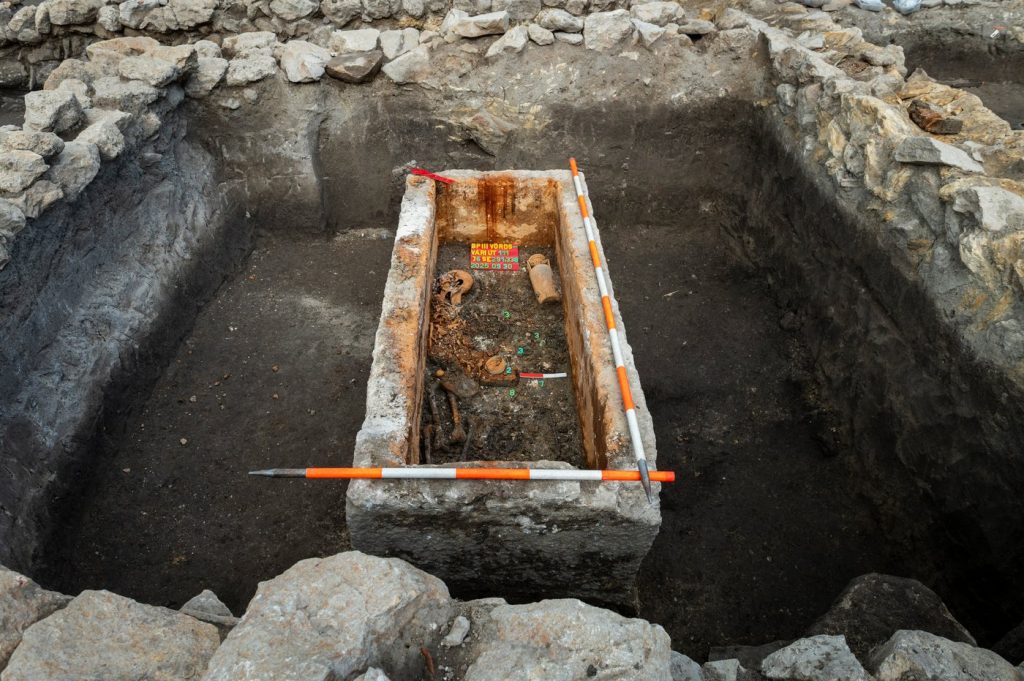A remarkably well-preserved Roman sarcophagus has been discovered in Budapest, Hungary, shedding light on the life of a young woman who lived approximately 1,700 years ago. Archaeologists from the Budapest History Museum unearthed the limestone coffin during a large-scale excavation in Óbuda, a district that was once part of Aquincum, a vibrant Roman settlement situated along the Danube River.
The sarcophagus, which remained untouched by looters and sealed for centuries, was found with its stone lid securely in place, held down by metal clamps and molten lead. When the researchers carefully lifted the lid, they revealed a complete skeleton nestled among numerous artifacts.
According to Gabriella Fényes, the lead archaeologist for the excavation, the significance of this find lies in the fact that it was hermetically sealed and completely intact. She remarked, “The peculiarity of the finding is that it was a hermetically sealed sarcophagus. It was not disturbed previously, so it was intact.” The coffin was located among the remnants of abandoned houses in an area of Aquincum that had been vacated during the 3rd century and later turned into a burial site.
Close to the sarcophagus, additional archaeological features were uncovered, including a Roman aqueduct and eight simpler graves, yet none matched the wealth or perfect condition of the sealed tomb. Following Roman funerary customs, the contents of the sarcophagus consisted of several items intended for the deceased’s journey into the afterlife. These included two intact glass vessels, bronze figures, and a remarkable total of 140 coins. Analysis of a bone hairpin, a piece of amber jewelry, and implies of gold-threaded fabric, coupled with the size of the skeleton, suggests that the grave likely belonged to a young woman.
Fényes explained that these artifacts were given to the deceased by her relatives as part of their effort to honor her memory. “The deceased was buried very carefully by her relatives. They must have really loved who they buried here,” she commented on the emotional significance of the burial.
During the Roman period, much of present-day Hungary was part of the province of Pannonia, which had its frontier less than a mile from the archaeological site. The uncovered structures are believed to have been part of the civilian settlement that developed around a nearby legionary camp that was established to protect the empire’s edge.
Anthropologists are set to analyze the remains of the young woman, a process that is expected to yield more information regarding her age, health, and origins. Despite the ongoing analysis, the positioning of the grave and the abundant artifacts suggest that the deceased likely held a higher social status. Gergely Kostyál, a Roman-period specialist and co-leader of the excavation, remarked on the rarity of such a find, stating, “It is truly rare to find a sarcophagus like this, untouched and never used before.” He emphasized the thoughtfulness that went into the construction of the sarcophagus, indicating it was made specifically for the woman interred within it.
Excavators also discovered about 4 centimeters (1.5 inches) of mud inside the coffin, which Fényes hopes may contain additional treasures. “I suspect we could find jewelry. We haven’t found any earrings or other jewelry belonging to the woman, so I hope that these small items will turn up during the sifting of the mud,” she indicated, expressing a hopeful outlook for further findings.
For Gabriella Fényes, this Roman sarcophagus represents more than just a significant scientific discovery; it offers a poignant glimpse into the emotional bonds and care displayed by people in ancient times. “I was very touched by the care and expression of love that we were able to get a glimpse of,” she shared, reflecting on the emotional weight of the burial process during that era. “Even now, I shudder to think how painful it must have been for the people at that time to bury this young lady.”










